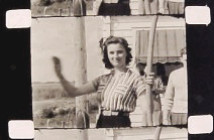V-E +1
Sam Fuller, 22 min., 16mm, 1945
Preserved by the Fuller Family and the Academy Film Archive
Added to National Film Registry: 2014
Excerpt from A Third Face: My Tale of Writing, Fighting and Filmmaking by Samuel Fuller. Applause Books (2004), pp. 215-217.
The town of Falkenau was a respectful community with upstanding townspeople living in clean homes with flower boxes on their windows. It didn’t seem possible that just over the hill were hundreds of miserable people in subhuman conditions who had only two ways out. Quickly, in a gas chamber. Or slowly, by disease and starvation.
The commander of our battalion, Captain Kimble R. Richmond, took a squad into Falkenau and rounded up the mayor, the butcher, the baker, and other respected townspeople. He wanted to know how the hell they could go about their everyday lives while people were dying in the nearby camp. Every one of them swore that they didn’t have any idea of what was going on in the Konzentrationslager. Most said they were against Hitler. Captain Richmond was disgusted. We’d learned to doubt the avowals from civilians throughout our campaign. Every Arab in North Africa claimed he was anti-Nazi. Every Frenchman swore allegiance to the Free French. Sicilians hated Mussolini. Belgians hated Hitler. We’d discover, as expected, more and more Germans who’d never been members of the Nazi Party.
Captain Richmond ordered a delegation of townspeople to appear at the gates of the camp the next morning or face a firing squad. Richmond was going to make sure that these people found out what had been happening only a few steps from their front doors. That evening I was called to the battalion CP. Richmond and I had a good relationship ever since he’d been slightly wounded by a Nazi bullet that had punctured his steel helmet. When he came out from the clinic, he was looking for his helmet. He considered it his good luck charm. I was the one who’d been keeping it for him.
“Sonofabitch,” said Captain Richmond, smiling as I gave him the helmet with the bullet hole, “if you want a helmet like this, Fuller, you’ll have to get shot at!”
Richmond knew my mother had sent me a handheld Bell & Howell 16-mm movie camera. The captain wanted me to position myself the next day on a wall overlooking the concentration camp to film the gruesome spectacle. I was about to make my first movie.
I started shooting footage of Captain Richmond giving the upstanding citizens of Falkenau his orders. They were to prepare the camp’s victims for a decent funeral, then take them to the burial site on a wagon. That way, they could never say again that they didn’t know what was happening in their own backyard. I filmed a couple dozen corpses being taken out of that putrid hut against the camp’s wall and laid out one by one, wrapped in white sheets on the ground, then piled on the wagon. When the wagon was full of corpses, the townspeople pushed it out of the camp to the specially prepared burial site. POWs, mostly teenage Hitlerjugend, helped place the shrouded corpses in a mass grave. One of our chaplains said a brief prayer. Earth was then shoveled into the mass grave. As paltry a consolation it was, these Nazi victims were buried with dignity.
My twenty minutes of 16-mm film had recorded the sober reckoning of those civilians. The spectacle was heart-wrenching, leaving me numb. I’d recorded evidence of man’s indescribable cruelty, a reality that the perpetrators might try to deny. However, a motion-picture camera doesn’t lie. When I finally got home, in the fall of 1945, I put that footage away and never took it out again. It would be too painful to watch, bringing back all the horrors of the war years. Those twenty minutes were a testament to the victims at Falkenau and to all the millions of people who died in Nazi death camps.
Samuel Fuller (1912-1997) was a screenwriter, novelist and film director.

